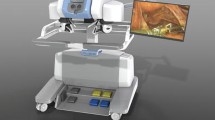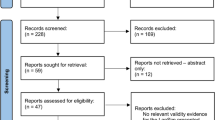Abstract
Background
The acquisition of technical skills using surgical simulators is an area of active research and rapidly evolving technology. The LapSim is a virtual reality simulator that currently allows practice of basic laparoscopic skills and some procedures. To date, no reviews have been published with reference to a single virtual reality simulator.
Methods
A PubMed search was performed using the keyword “LapSim,” with further papers identified from the citations of original search articles.
Results
Use of the LapSim to develop surgical skills has yielded overall results, although inconsistencies exist. Data regarding the transferability of learned skills to the operative environment are encouraging as is the validation work, particularly the use of a combination of measured parameters to produce an overall comparative performance score.
Conclusion
Although the LapSim currently does not have any proven significant advantages over video trainers in terms of basic skills instruction and although the results of validation studies are variable, the potential for such technology to have a huge impact on surgical training is apparent. Work to determine standardized learning curves and proficiency criteria for different levels of trainees is incomplete. Moreover, defining which performance parameters measured by the LapSim accurately determine laparoscopic skill is complex. Further technological advances will undoubtedly improve the efficacy of the LapSim, and the results of large multicenter trials are anticipated.

Similar content being viewed by others
References
The Intercollegiate Surgical Curriculum Project. http://www.iscp.ac.uk. Retrieved 17 September 2009
Soper NJ, Fried GM (2008) The fundamentals of laparoscopic surgery: its time has come. Bull Am Coll Surg 93:30–32
Gurusamy KS, Aggarwal R, Palanivelu L, Davidson BR (2009) Virtual reality training for surgical trainees in laparoscopic surgery. Cochrane Database Syst Rev CD006575
Carter FJ, Schijven MP, Aggarwal R, Grantcharov T, Francis NK, Hanna GB, Jakimowicz JJ (2005) Consensus guidelines for validation of virtual reality surgical simulators. Surg Endosc 19:1523–1532
Sutherland LM, Middleton PF, Anthony A, Hamdorf J, Cregan P, Scott D, Maddern GJ (2006) Surgical simulation: a systematic review. Ann Surg 243:291–300
van der Meijden OA, Schijven MP (2009) The value of haptic feedback in conventional and robot-assisted minimal invasive surgery and virtual reality training: a current review. Surg Endosc 23:1180–1190
Tsuda S, Scott D, Doyle J, Jones DB (2009) Surgical skills training and simulation. Curr Probl Surg 46:271–370
Sturm LP, Windsor JA, Cosman PH, Cregan P, Hewett PJ, Maddern GJ (2008) A systematic review of skills transfer after surgical simulation training. Ann Surg 248:166–179
SurgicalScience. http://www.surgical-science.com. Retrieved 8 September 2009
Larsen CR, Soerensen JL, Grantcharov TP, Dalsgaard T, Schouenborg L, Ottosen C, Schroeder TV, Ottesen BS (2009) Effect of virtual reality training on laparoscopic surgery: randomised controlled trial. BMJ 338:b1802
Ahlberg G, Enochsson L, Gallagher AG, Hedman L, Hogman C, McClusky DA III, Ramel S, Smith CD, Arvidsson D (2007) Proficiency-based virtual reality training significantly reduces the error rate for residents during their first 10 laparoscopic cholecystectomies. Am J Surg 193:797–804
Cosman PH, Hugh TJ, Shearer CJ, Merrett ND, Biankin AV, Cartmill JA (2007) Skills acquired on virtual reality laparoscopic simulators transfer into the operating room in a blinded, randomised, controlled trial. Stud Health Technol Inform 125:76–81
Hyltander A, Liljegren E, Rhodin PH, Lonroth H (2002) The transfer of basic skills learned in a laparoscopic simulator to the operating room. Surg Endosc 16:1324–1328
Youngblood PL, Srivastava S, Curet M, Heinrichs WL, Dev P, Wren SM (2005) Comparison of training on two laparoscopic simulators and assessment of skills transfer to surgical performance. J Am Coll Surg 200:546–551
SimuLab Corporation. http://www.simulab.com/product/surgery/laparoscopic/tower-trainer. Retrieved 15 September 2009
Munz Y, Kumar BD, Moorthy K, Bann S, Darzi A (2004) Laparoscopic virtual reality and box trainers: is one superior to the other? Surg Endosc 18:485–494
Newmark J, Dandolu V, Milner R, Grewal H, Harbison S, Hernandez E (2007) Correlating virtual reality and box trainer tasks in the assessment of laparoscopic surgical skills. Am J Obstet Gynecol 197:546e1–546e4
Munz Y, Almoudaris AM, Moorthy K, Dosis A, Liddle AD, Darzi AW (2007) Curriculum-based solo virtual reality training for laparoscopic intracorporeal knot tying: objective assessment of the transfer of skill from virtual reality to reality. Am J Surg 193:774–783
Mentice. http://www.mentice.com. Retrieved 15 September 2009
Hogle NJ, Widmann WD, Ude AO, Hardy MA, Fowler DL (2008) Does training novices to criteria and does rapid acquisition of skills on laparoscopic simulators have predictive validity or are we just playing video games? J Surg Educ 65:431–435
Hogle NJ, Chang L, Strong VE, Welcome AO, Sinaan M, Bailey R, Fowler DL (2009) Validation of laparoscopic surgical skills training outside the operating room: a long road. Surg Endosc 23:1476–1482
Vassiliou MC, Feldman LS, Andrew CG, Bergman S, Leffondre K, Stanbridge D, Fried GM (2005) A global assessment tool for evaluation of intraoperative laparoscopic skills. Am J Surg 190:107–113
Botden SM, Buzink SN, Schijven MP, Jakimowicz JJ (2007) Augmented versus virtual reality laparoscopic simulation: what is the difference? A comparison of the ProMIS augmented reality laparoscopic simulator versus LapSim virtual reality laparoscopic simulator. World J Surg 31:764–772
Pellen MG, Horgan LF, Barton JR, Attwood SE (2009) Construct validity of the ProMIS laparoscopic simulator. Surg Endosc 23:130–139
Pellen M, Horgan L, Roger Barton J, Attwood S (2009) Laparoscopic surgical skills assessment: can simulators replace experts? World J Surg 33:440–447
Aggarwal R, Grantcharov TP, Eriksen JR, Blirup D, Kristiansen VB, Funch-Jensen P, Darzi A (2006) An evidence-based virtual reality training program for novice laparoscopic surgeons. Ann Surg 244:310–314
Duffy AJ, Hogle NJ, McCarthy H, Lew JI, Egan A, Christos P, Fowler DL (2005) Construct validity for the LapSim laparoscopic surgical simulator. Surg Endosc 19:401–405
Eriksen JR, Grantcharov T (2005) Objective assessment of laparoscopic skills using a virtual reality stimulator. Surg Endosc 19:1216–1219
Hassan I, Sitter H, Schlosser K, Zielke A, Rothmund M, Gerdes B (2005) A virtual reality simulator for objective assessment of surgeons’ laparoscopic skill. Chirurg 76:151–156
Langelotz C, Kilian M, Paul C, Schwenk W (2005) LapSim virtual reality laparoscopic simulator reflects clinical experience in German surgeons. Langenbecks Arch Surg 390:534–537
Larsen CR, Grantcharov T, Aggarwal R, Tully A, Sorensen JL, Dalsgaard T, Ottesen B (2006) Objective assessment of gynecologic laparoscopic skills using the LapSimGyn virtual reality simulator. Surg Endosc 20:1460–1466
Sherman V, Feldman LS, Stanbridge D, Kazmi R, Fried GM (2005) Assessing the learning curve for the acquisition of laparoscopic skills on a virtual reality simulator. Surg Endosc 19:678–682
van Dongen KW, Tournoij E, van der Zee DC, Schijven MP, Broeders IA (2007) Construct validity of the LapSim: can the LapSim virtual reality simulator distinguish between novices and experts? Surg Endosc 21:1413–1417
Woodrum DT, Andreatta PB, Yellamanchilli RK, Feryus L, Gauger PG, Minter RM (2006) Construct validity of the LapSim laparoscopic surgical simulator. Am J Surg 191:28–32
Danila R, Gerdes B, Ulrike H, Dominguez Fernandez E, Hassan I (2009) Objective evaluation of minimally invasive surgical skills for transplantation: surgeons using a virtual reality simulator. Chirurgia Bucur 104:181–185
Panait L, Bell RL, Roberts KE, Duffy AJ (2008) Designing and validating a customized virtual reality-based laparoscopic skills curriculum. J Surg Educ 65:413–417
Aggarwal R, Ward J, Balasundaram I, Sains P, Athanasiou T, Darzi A (2007) Proving the effectiveness of virtual reality simulation for training in laparoscopic surgery. Ann Surg 246:771–779
Dosis A, Aggarwal R, Bello F, Moorthy K, Munz Y, Gillies D, Darzi A (2005) Synchronized video and motion analysis for the assessment of procedures in the operating theater. Arch Surg 140:293–299
Martin JA, Regehr G, Reznick R, MacRae H, Murnaghan J, Hutchison C, Brown M (1997) Objective structured assessment of technical skill (OSATS) for surgical residents. Br J Surg 84:273–278
Hassan I, Maschuw K, Rothmund M, Koller M, Gerdes B (2006) Novices in surgery are the target group of a virtual reality training laboratory. Eur Surg Res 38:109–113
Ro CY, Toumpoulis IK, Ashton RC Jr, Jebara T, Schulman C, Todd GJ, Derose JJ Jr, McGinty JJ (2005) The LapSim: a learning environment for both experts and novices. Stud Health Technol Inform 111:414–417
Hassan I, Koller M, Zielke A, Lehmann K, Rothmund M, Gerdes B (2006) Improvement of surgical skills after a three-day practical course for laparoscopic surgery. Swiss Med Wkly 136:631–636
Hassan I, Gerdes B, Koller M, Langer P, Rothmund M, Zielke A (2006) Clinical background is required for optimum performance with a VR laparoscopy simulator. Comput Aided Surg 11:103–106
Panait L, Rafiq A, Tomulescu V, Boanca C, Popescu I, Carbonell A, Merrell RC (2006) Telementoring versus on-site mentoring in virtual reality-based surgical training. Surg Endosc 20:113–118
Royal Australasian College of Surgeons. http://www.surgeons.org/content/NavigationMenu/EducationandTraining/Training/Standardsandprotocols/Assessment/default.htm. Retrieved 12 September 2009
Kundhal PS, Grantcharov TP (2009) Psychomotor performance measured in a virtual environment correlates with technical skills in the operating room. Surg Endosc 23:645–649
Tomulescu V, Popescu I (2004) The use of LapSim virtual reality simulator in the evaluation of laparoscopic surgery skill: preliminary results. Chirurgia Bucur 99:523–527
Grantcharov TP, Kristiansen VB, Bendix J, Bardram L, Rosenberg J, Funch-Jensen P (2004) Randomized clinical trial of virtual reality simulation for laparoscopic skills training. Br J Surg 91:146–150
Faulkner H, Regehr G, Martin J, Reznick R (1996) Validation of an objective structured assessment of technical skill for surgical residents. Acad Med 71:1363–1365
Hogle NJ, Briggs WM, Fowler DL (2007) Documenting a learning curve and test–retest reliability of two tasks on a virtual reality training simulator in laparoscopic surgery. J Surg Educ 64:424–430
Schlosser K, Alkhawaga M, Maschuw K, Zielke A, Mauner E, Hassan I (2007) Training of laparoscopic skills with virtual reality simulator:a critical reappraisal of the learning curve. Eur Surg 39:180–184
Aggarwal R, Tully A, Grantcharov T, Larsen CR, Miskry T, Farthing A, Darzi A (2006) Virtual reality simulation training can improve technical skills during laparoscopic salpingectomy for ectopic pregnancy. BJOG 113:1382–1387
Sinha P, Hogle NJ, Fowler DL (2008) Do the laparoscopic skills of trainees deteriorate over time? Surg Endosc 22:2018–2025
Salgado J, Grantcharov TP, Papasavas PK, Gagne DJ, Caushaj PF (2009) Technical skills assessment as part of the selection process for a fellowship in minimally invasive surgery. Surg Endosc 23:641–644
Darzi A, Smith S, Taffinder N (1999) Assessing operative skill: needs to become more objective. BMJ 318:887–888
Hassan I, Weyers P, Maschuw K, Dick B, Gerdes B, Rothmund M, Zielke A (2006) Negative stress-coping strategies among novices in surgery correlate with poor virtual laparoscopic performance. Br J Surg 93:1554–1559
Schuetz M, Gockel I, Beardi J, Hakman P, Dunschede F, Moenk S, Heinrichs W, Junginger T (2008) Three different types of surgeon-specific stress reactions identified by laparoscopic simulation in a virtual scenario. Surg Endosc 22:1263–1267
Maschuw K, Osei-Agyemang T, Weyers P, Danila R, Bin Dayne K, Rothmund M, Hassan I (2008) The impact of self-belief on laparoscopic performance of novices and experienced surgeons. World J Surg 32:1911–1916
Hassan I, Gerdes B, Koller M, Dick B, Hellwig D, Rothmund M, Zielke A (2007) Spatial perception predicts laparoscopic skills on virtual reality laparoscopy simulator. Childs Nerv Syst 23:685–689
Amercian College of Surgeons. http://www.facs.org/education/surgicalskills.html. Retrieved 18 September 2009
Disclosures
Katherine Fairhurst, Andrew Strickland, and Guy Maddern have no conflicts of interest or financial ties to disclose.
Author information
Authors and Affiliations
Corresponding author
Rights and permissions
About this article
Cite this article
Fairhurst, K., Strickland, A. & Maddern, G. The LapSim virtual reality simulator: promising but not yet proven. Surg Endosc 25, 343–355 (2011). https://doi.org/10.1007/s00464-010-1181-0
Received:
Accepted:
Published:
Issue Date:
DOI: https://doi.org/10.1007/s00464-010-1181-0




